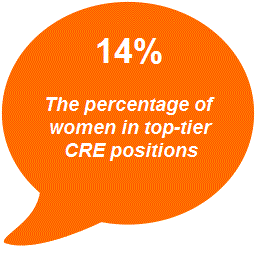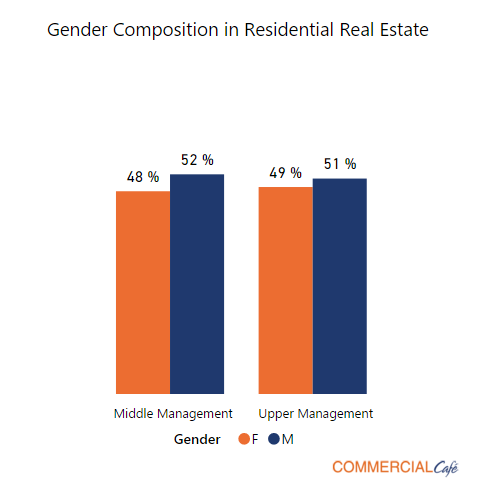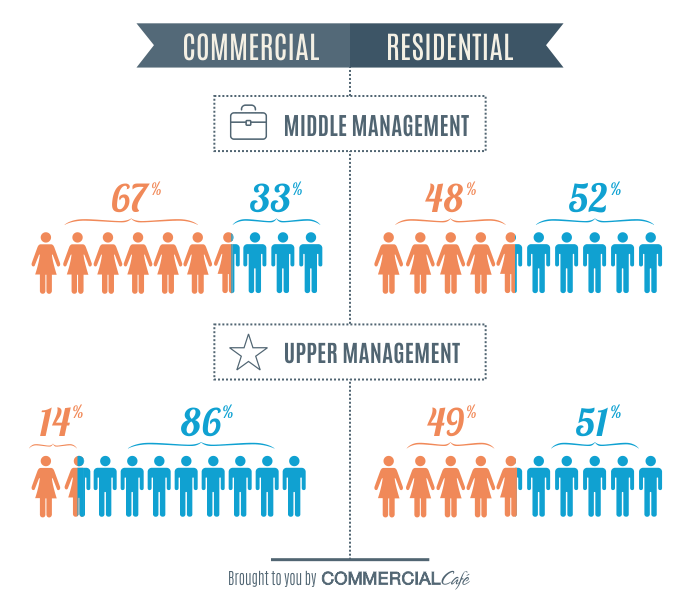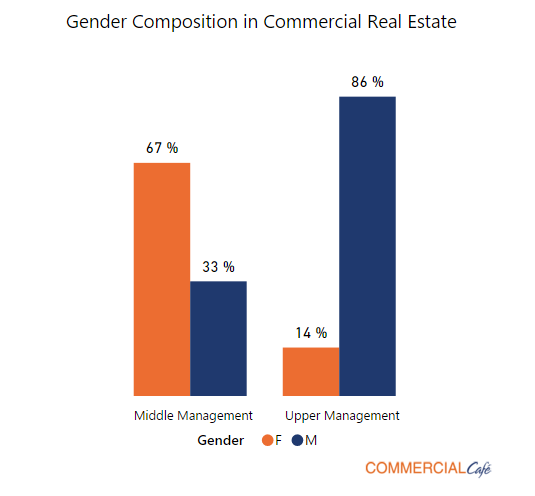Gender bias seems to be everywhere, even in today’s open-minded, equal-opportunity society. Fields like politics, finance, and real estate have historically been ruled by men, and it’s hard to break out of that ingrained mindset. Though the situation has improved drastically over the last couple of decades, when it comes to the commercial side of the real estate business, it seems the upper tier of leadership is still dominated by men.
We thought this was an issue worth diving into, so we looked at the distribution of male and female employees occupying management positions within some of the largest real estate services companies in the U.S., where information related to organizational structure was publicly available. Our analysis included a set of 11 commercial real estate-focused companies and 8 residential real estate services firms. We divided all the positions into two tiers: the middle management tier includes general managers, regional managers, marketing managers, operations managers, research managers, and so on, while the upper tier includes C-suite, president, chairman, partner, director, and principal positions.
On a national level, there is a significant discrepancy with regard to female representation in residential real estate versus the commercial realm. The gender gap in residential real estate is virtually non-existent, across all tiers, while on the commercial side, male employees continue to occupy most of the top-tier positions. However, what our research revealed is that women seem to dominate the middle management level in CRE, with just 33% of positions reserved for male employees. We dive into more detail below.
Commercial Real Estate is Still ‘A Man’s World’
 Commercial real estate, much like any other high-powered, high-risk industry, has a reputation of being a male-dominated environment. Regarded as a ‘rough and tough’ business, where chasing multi-million-dollar deals is a lot like a predator chasing its prey, the industry has historically been ruled by–you’ve guessed it–men. Antiquated notions have long been associated with the industry–men have a better chance at winning over clients and closing major deals, as women tend to be perceived as more emotional and likely to cave under the pressure that comes with the job. It’s no wonder then that the subject of diversity and female representation is still a sensitive one.
Commercial real estate, much like any other high-powered, high-risk industry, has a reputation of being a male-dominated environment. Regarded as a ‘rough and tough’ business, where chasing multi-million-dollar deals is a lot like a predator chasing its prey, the industry has historically been ruled by–you’ve guessed it–men. Antiquated notions have long been associated with the industry–men have a better chance at winning over clients and closing major deals, as women tend to be perceived as more emotional and likely to cave under the pressure that comes with the job. It’s no wonder then that the subject of diversity and female representation is still a sensitive one.
Women Occupy 67% of Middle Management Positions in CRE, But Only 14% of Upper Roles
Our study shows that, on a nationwide level, only 14% of top-tier jobs in commercial real estate are held by women, while male employees occupy 86% of upper management positions–quite a wide gender gap. Our research indicates an apparent exception at the middle management level, where 67% of positions are currently occupied by women, and just 33% by men. Yet going up the ladder to the executive level, female representation drops dramatically. Why does this transition seem so difficult for women? Is middle management some kind of commercial real estate glass ceiling?
One reason for the low number of women in top-tier CRE positions is that turnover is very slow in the commercial business. Top-level executives are often the very people who founded the company in the first place, and they tend to hold their positions for decades. What usually follows is that the executive selected as replacement is another key player with a long history within the company. And since the largest firms in the industry were founded decades ago, when the gender gap was significantly wider, it’s no surprise that the highest ranks are mostly still occupied by men (CBRE was established in 1906, Cushman & Wakefield in 1917 and NGKF in 1929).
No Gender Gap on the Residential Side
Research conducted by The Real Deal in January found ‘a tale of two sectors’ when comparing the number of commercial and residential female executives on the New York City market. Zooming out to a nationwide perspective reveals the same stark differences. The residential sector might not be quite as fast-paced and business-focused as the commercial side, so the barrier to entry for high-ranking female executives is not as hard to break. Some of the biggest players on the residential market are currently fronted by female CEOs, even in highly-competitive markets like New York (e.g. Dottie Herman of Douglas Elliman and Pamela Liebman of the Corcoran Group). Residential real estate appears to be one of very few industries where men and women are equally represented.
 Our analysis shows that 49% of upper management positions in the residential sector are occupied by women, with 51% of roles held by men–a much smaller gender gap compared to the commercial side. The situation is just as balanced at middle management level, with 48% of positions held by women and 52% by men. It would seem that the residential sector is doing a much better job at narrowing the gender gap, offering more opportunities for women to rise through the ranks and occupy leadership positions.
Our analysis shows that 49% of upper management positions in the residential sector are occupied by women, with 51% of roles held by men–a much smaller gender gap compared to the commercial side. The situation is just as balanced at middle management level, with 48% of positions held by women and 52% by men. It would seem that the residential sector is doing a much better job at narrowing the gender gap, offering more opportunities for women to rise through the ranks and occupy leadership positions.
Is the Situation Any Different in Other Fields?
Commercial real estate is not the only industry where the gender gap is still significantly wide. A recent Financial Times study found that progress is just as slow, or even slower, in the financial services sector. According to the analysis, just one in four of those in senior financial services roles is female, the equivalent of just 25.5% of the total number of senior jobs. A survey quoted by CNBC also showed that men are 41% more likely to land management roles over the course of their careers, and nearly twice as likely to reach executive positions in the late stages of their working careers. The disparity, per the study, is most pronounced in the finance and insurance sectors, while in non-medical STEM fields, the scale is tipped in favor of women. This goes to show how difficult it is for women to rise through the ranks in industries that have historically been dominated by men. Yet progress, albeit slow, is happening, with many different studies raising awareness on the issue and forcing companies to pay more attention to their hiring and promoting strategies.











